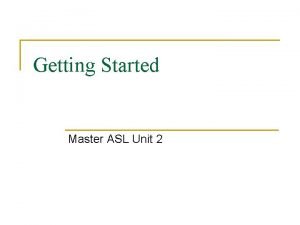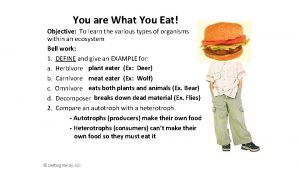Working together to help you learn more Class











- Slides: 11

Working together to help you learn more Class: Beech and Walnut Subject: Science DATE: 30 TH MARCH – 3 RD APRIL 2020

Task 1 A project on plants? Draw a flowering plant like this one Carefully label the flower, the stem, the leaf, the roots Can you write under each label what they do ? Yes – write a sentence under each label to explain- then click to next slide to check your work No – write down what you do know then click to next slide for help to complete

Check your knowledge Correct any mistakes Add any detail missed Colour your plant Click onto next slide Some plants have flowers. These are involved in reproduction and produce seeds from which new plants grow. The stem carries water and nutrients to different parts of the plant. The leaves use light from the sun, along with carbon dioxide from the air and water to make food for the plant. This process is called photosynthesis. The roots of a plant take up water and nutrients from the soil. The roots also keep the plant steady and upright in the soil.

If you have a garden go outside and look at some plants see how they all differ – size of leaves, shape, colour of flowers etc Looking at plants If you cannot get outside look online at some pictures of flowers and plants from different areas Make some notes or take photos to add to your plant project

Watch and learn Go to this website and watch the video https: //www. bbc. co. uk/bitesize/topics/zdqdcqt/articles/zcmtk 2 p Recap – can you explain to an adult what do plants need to survive?

Lesson 2 Flowers reproduction Plants reproduce in two ways Sexually Asexually This lesson I want you to look at sexual reproduction in plants Next slide Some plants have flowers. These are involved in reproduction and produce seeds from which new plants grow.

What do all these flowers have in common? Click to find out… They are all insect pollinated

Flowers https: //www. bbc. co. uk/teach/class-clips-video/science-ks 2 -ks 3 -how-plants-andanimals-reproduce/zm 8 fbdm Watch the video clip On next slide is a diagram Label the parts of the flower Extension : Explain what they do

Either print out this or similar from internet or draw yourself or find a photo in magazine or take a photo and print out label the flower parts and say what they do Check your work on next slide

Petals: attract insects Anthers: produce pollen Stigma: pollen is deposited to fertilize here tohere fertilize flower

Growing Ask someone in the house to give you a seed to plant and grow. Take a photo of it every day and make a diary of its progress. Ideas: because we cant go to the shops……. If you don’t have seeds Old potatoes - if they have sprouting roots plant in ground – you might even have lots of potatoes by July! If you have fresh tomatoes, apples, pears, anything with pips or seeds eat most of it they are good for you BUT save a couple of seeds from the middle and plant them in compost if you have it if not try fine soil. You might have fresh tomatoes by July too!
 Lirik lagu more more more we praise you
Lirik lagu more more more we praise you More more more i want more more more more we praise you
More more more i want more more more more we praise you The more you study the more you learn
The more you study the more you learn 5 apples in a basket riddle
5 apples in a basket riddle Freesurfer troubleshooting
Freesurfer troubleshooting Help us help you
Help us help you Master asl unit 2 pdf
Master asl unit 2 pdf Kinetic learning
Kinetic learning Man lernt solange man lebt
Man lernt solange man lebt What is a herbivore
What is a herbivore Working smart vs working hard
Working smart vs working hard Cold working of metals
Cold working of metals





















